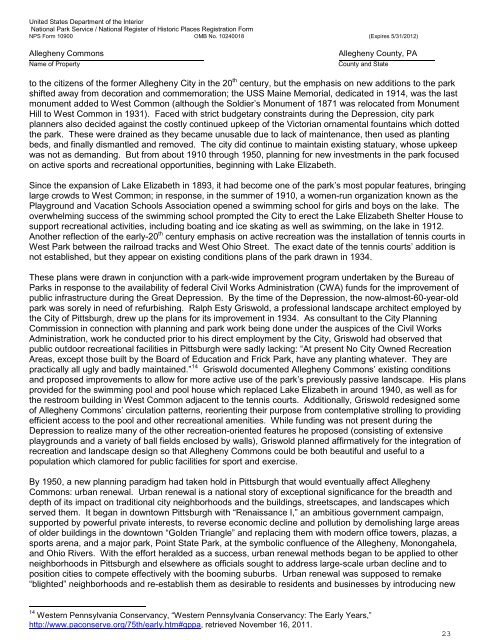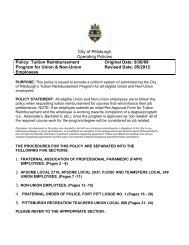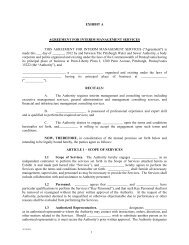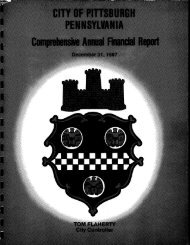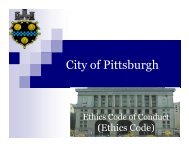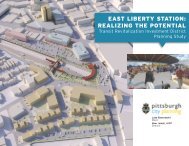Allegheny Commons - City of Pittsburgh
Allegheny Commons - City of Pittsburgh
Allegheny Commons - City of Pittsburgh
You also want an ePaper? Increase the reach of your titles
YUMPU automatically turns print PDFs into web optimized ePapers that Google loves.
United States Department <strong>of</strong> the InteriorNational Park Service / National Register <strong>of</strong> Historic Places Registration FormNPS Form 10900 OMB No. 10240018 (Expires 5/31/2012)<strong>Allegheny</strong> <strong>Commons</strong>Name <strong>of</strong> Property<strong>Allegheny</strong> County, PACounty and Stateto the citizens <strong>of</strong> the former <strong>Allegheny</strong> <strong>City</strong> in the 20 th century, but the emphasis on new additions to the parkshifted away from decoration and commemoration; the USS Maine Memorial, dedicated in 1914, was the lastmonument added to West Common (although the Soldier’s Monument <strong>of</strong> 1871 was relocated from MonumentHill to West Common in 1931). Faced with strict budgetary constraints during the Depression, city parkplanners also decided against the costly continued upkeep <strong>of</strong> the Victorian ornamental fountains which dottedthe park. These were drained as they became unusable due to lack <strong>of</strong> maintenance, then used as plantingbeds, and finally dismantled and removed. The city did continue to maintain existing statuary, whose upkeepwas not as demanding. But from about 1910 through 1950, planning for new investments in the park focusedon active sports and recreational opportunities, beginning with Lake Elizabeth.Since the expansion <strong>of</strong> Lake Elizabeth in 1893, it had become one <strong>of</strong> the park’s most popular features, bringinglarge crowds to West Common; in response, in the summer <strong>of</strong> 1910, a women-run organization known as thePlayground and Vacation Schools Association opened a swimming school for girls and boys on the lake. Theoverwhelming success <strong>of</strong> the swimming school prompted the <strong>City</strong> to erect the Lake Elizabeth Shelter House tosupport recreational activities, including boating and ice skating as well as swimming, on the lake in 1912.Another reflection <strong>of</strong> the early-20 th century emphasis on active recreation was the installation <strong>of</strong> tennis courts inWest Park between the railroad tracks and West Ohio Street. The exact date <strong>of</strong> the tennis courts’ addition isnot established, but they appear on existing conditions plans <strong>of</strong> the park drawn in 1934.These plans were drawn in conjunction with a park-wide improvement program undertaken by the Bureau <strong>of</strong>Parks in response to the availability <strong>of</strong> federal Civil Works Administration (CWA) funds for the improvement <strong>of</strong>public infrastructure during the Great Depression. By the time <strong>of</strong> the Depression, the now-almost-60-year-oldpark was sorely in need <strong>of</strong> refurbishing. Ralph Esty Griswold, a pr<strong>of</strong>essional landscape architect employed bythe <strong>City</strong> <strong>of</strong> <strong>Pittsburgh</strong>, drew up the plans for its improvement in 1934. As consultant to the <strong>City</strong> PlanningCommission in connection with planning and park work being done under the auspices <strong>of</strong> the Civil WorksAdministration, work he conducted prior to his direct employment by the <strong>City</strong>, Griswold had observed thatpublic outdoor recreational facilities in <strong>Pittsburgh</strong> were sadly lacking: “At present No <strong>City</strong> Owned RecreationAreas, except those built by the Board <strong>of</strong> Education and Frick Park, have any planting whatever. They arepractically all ugly and badly maintained.” 14 Griswold documented <strong>Allegheny</strong> <strong>Commons</strong>’ existing conditionsand proposed improvements to allow for more active use <strong>of</strong> the park’s previously passive landscape. His plansprovided for the swimming pool and pool house which replaced Lake Elizabeth in around 1940, as well as forthe restroom building in West Common adjacent to the tennis courts. Additionally, Griswold redesigned some<strong>of</strong> <strong>Allegheny</strong> <strong>Commons</strong>’ circulation patterns, reorienting their purpose from contemplative strolling to providingefficient access to the pool and other recreational amenities. While funding was not present during theDepression to realize many <strong>of</strong> the other recreation-oriented features he proposed (consisting <strong>of</strong> extensiveplaygrounds and a variety <strong>of</strong> ball fields enclosed by walls), Griswold planned affirmatively for the integration <strong>of</strong>recreation and landscape design so that <strong>Allegheny</strong> <strong>Commons</strong> could be both beautiful and useful to apopulation which clamored for public facilities for sport and exercise.By 1950, a new planning paradigm had taken hold in <strong>Pittsburgh</strong> that would eventually affect <strong>Allegheny</strong><strong>Commons</strong>: urban renewal. Urban renewal is a national story <strong>of</strong> exceptional significance for the breadth anddepth <strong>of</strong> its impact on traditional city neighborhoods and the buildings, streetscapes, and landscapes whichserved them. It began in downtown <strong>Pittsburgh</strong> with “Renaissance I,” an ambitious government campaign,supported by powerful private interests, to reverse economic decline and pollution by demolishing large areas<strong>of</strong> older buildings in the downtown “Golden Triangle” and replacing them with modern <strong>of</strong>fice towers, plazas, asports arena, and a major park, Point State Park, at the symbolic confluence <strong>of</strong> the <strong>Allegheny</strong>, Monongahela,and Ohio Rivers. With the effort heralded as a success, urban renewal methods began to be applied to otherneighborhoods in <strong>Pittsburgh</strong> and elsewhere as <strong>of</strong>ficials sought to address large-scale urban decline and toposition cities to compete effectively with the booming suburbs. Urban renewal was supposed to remake“blighted” neighborhoods and re-establish them as desirable to residents and businesses by introducing new14 Western Pennsylvania Conservancy, “Western Pennsylvania Conservancy: The Early Years,”http://www.paconserve.org/75th/early.htm#gppa, retrieved November 16, 2011.23


